Effective Risk Management Plan in Healthcare Organizations
VerifiedAdded on 2023/06/07
|7
|1269
|469
Report
AI Summary
This report presents a comprehensive risk management plan tailored for medical centers, addressing potential risks related to clinical operations, human resources, quality assurance, and occupational hazards. The plan emphasizes the importance of communication and consultation among stakeholders, risk identification and analysis, risk treatment through proactive measures, and continuous monitoring and reviewing of implemented strategies. Actionable steps and recommendations are provided to improve the overall performance of the organization and mitigate risks that could compromise patient care and organizational safety. The goal is to foster a culture of transparency and trust while ensuring the delivery of high-quality healthcare services.
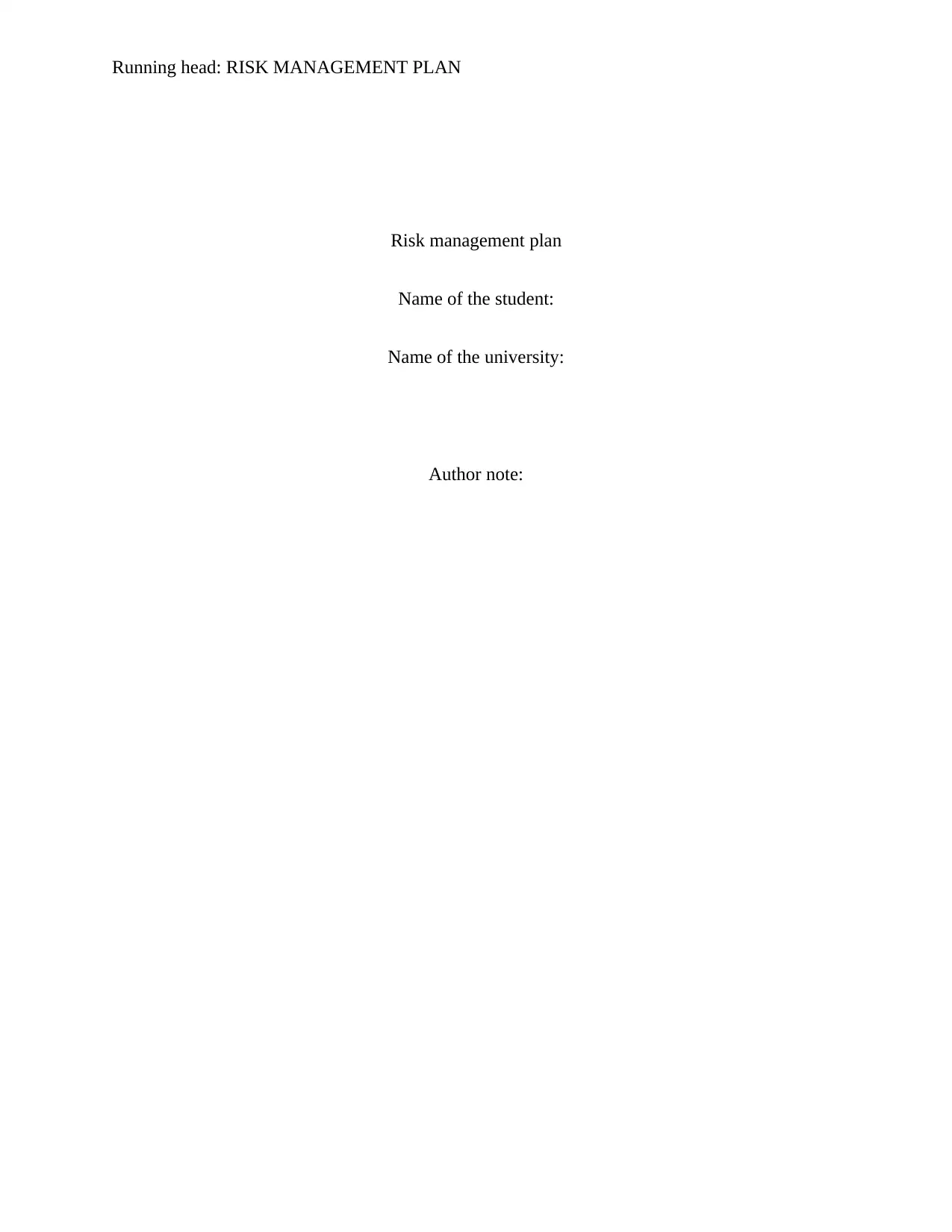
Running head: RISK MANAGEMENT PLAN
Risk management plan
Name of the student:
Name of the university:
Author note:
Risk management plan
Name of the student:
Name of the university:
Author note:
Paraphrase This Document
Need a fresh take? Get an instant paraphrase of this document with our AI Paraphraser
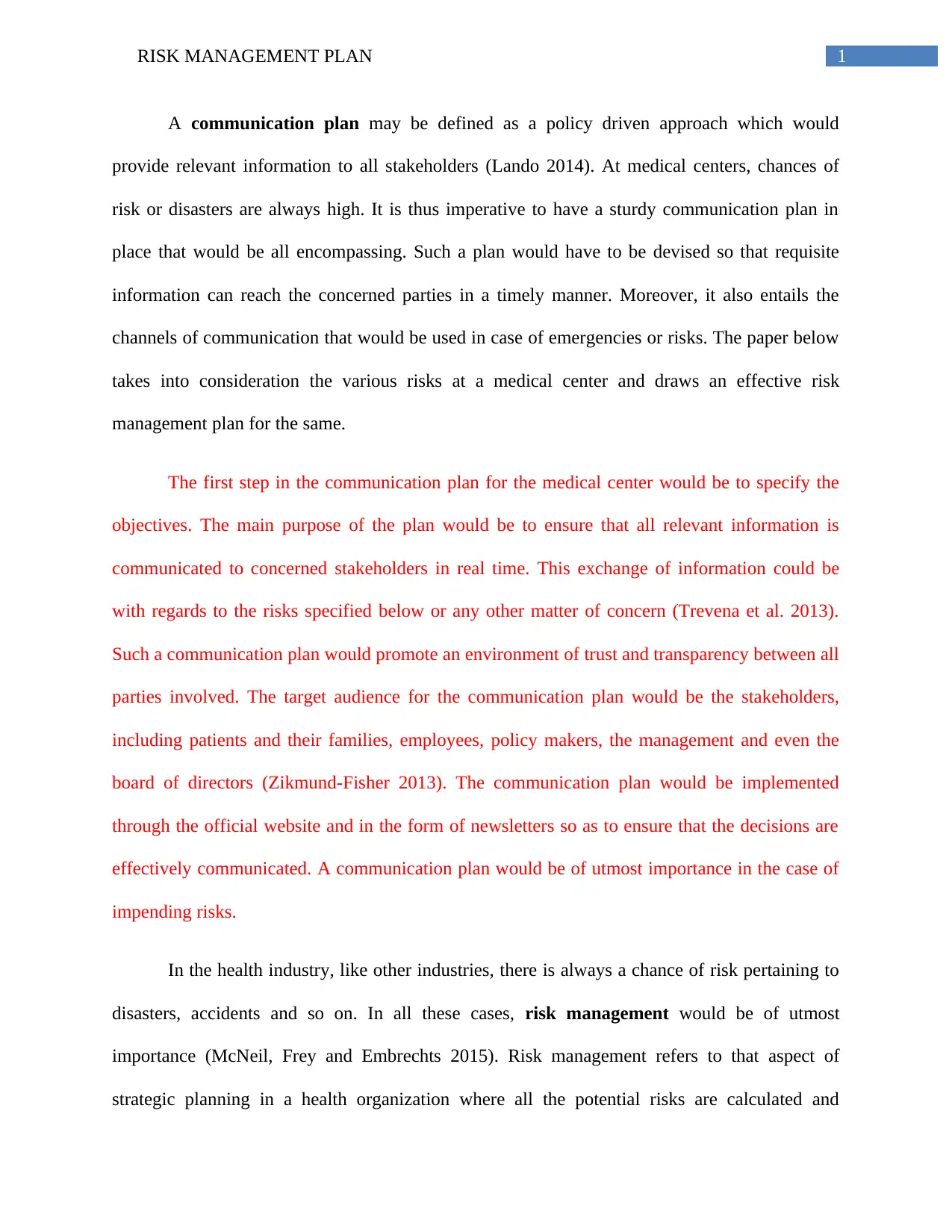
1RISK MANAGEMENT PLAN
A communication plan may be defined as a policy driven approach which would
provide relevant information to all stakeholders (Lando 2014). At medical centers, chances of
risk or disasters are always high. It is thus imperative to have a sturdy communication plan in
place that would be all encompassing. Such a plan would have to be devised so that requisite
information can reach the concerned parties in a timely manner. Moreover, it also entails the
channels of communication that would be used in case of emergencies or risks. The paper below
takes into consideration the various risks at a medical center and draws an effective risk
management plan for the same.
The first step in the communication plan for the medical center would be to specify the
objectives. The main purpose of the plan would be to ensure that all relevant information is
communicated to concerned stakeholders in real time. This exchange of information could be
with regards to the risks specified below or any other matter of concern (Trevena et al. 2013).
Such a communication plan would promote an environment of trust and transparency between all
parties involved. The target audience for the communication plan would be the stakeholders,
including patients and their families, employees, policy makers, the management and even the
board of directors (Zikmund-Fisher 2013). The communication plan would be implemented
through the official website and in the form of newsletters so as to ensure that the decisions are
effectively communicated. A communication plan would be of utmost importance in the case of
impending risks.
In the health industry, like other industries, there is always a chance of risk pertaining to
disasters, accidents and so on. In all these cases, risk management would be of utmost
importance (McNeil, Frey and Embrechts 2015). Risk management refers to that aspect of
strategic planning in a health organization where all the potential risks are calculated and
A communication plan may be defined as a policy driven approach which would
provide relevant information to all stakeholders (Lando 2014). At medical centers, chances of
risk or disasters are always high. It is thus imperative to have a sturdy communication plan in
place that would be all encompassing. Such a plan would have to be devised so that requisite
information can reach the concerned parties in a timely manner. Moreover, it also entails the
channels of communication that would be used in case of emergencies or risks. The paper below
takes into consideration the various risks at a medical center and draws an effective risk
management plan for the same.
The first step in the communication plan for the medical center would be to specify the
objectives. The main purpose of the plan would be to ensure that all relevant information is
communicated to concerned stakeholders in real time. This exchange of information could be
with regards to the risks specified below or any other matter of concern (Trevena et al. 2013).
Such a communication plan would promote an environment of trust and transparency between all
parties involved. The target audience for the communication plan would be the stakeholders,
including patients and their families, employees, policy makers, the management and even the
board of directors (Zikmund-Fisher 2013). The communication plan would be implemented
through the official website and in the form of newsletters so as to ensure that the decisions are
effectively communicated. A communication plan would be of utmost importance in the case of
impending risks.
In the health industry, like other industries, there is always a chance of risk pertaining to
disasters, accidents and so on. In all these cases, risk management would be of utmost
importance (McNeil, Frey and Embrechts 2015). Risk management refers to that aspect of
strategic planning in a health organization where all the potential risks are calculated and
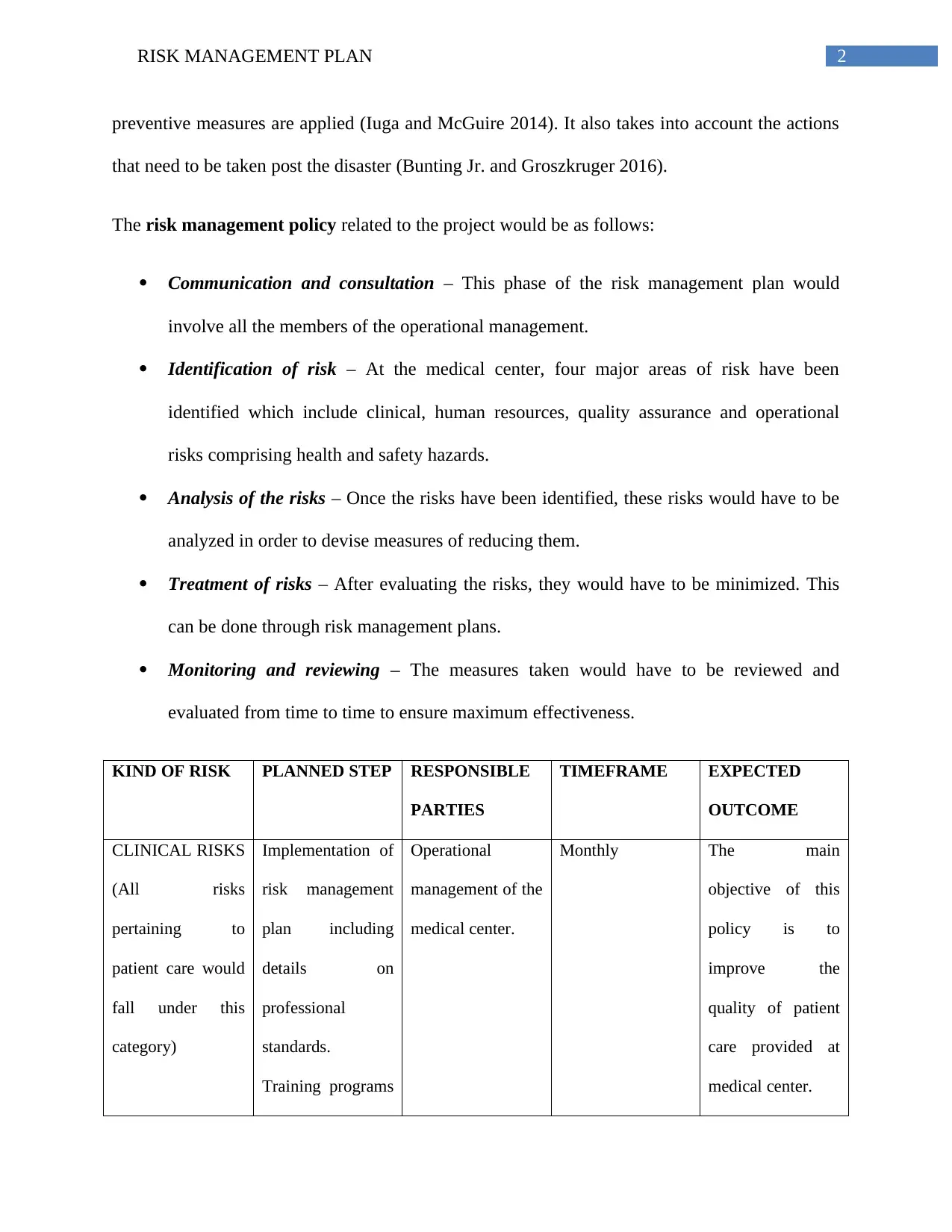
2RISK MANAGEMENT PLAN
preventive measures are applied (Iuga and McGuire 2014). It also takes into account the actions
that need to be taken post the disaster (Bunting Jr. and Groszkruger 2016).
The risk management policy related to the project would be as follows:
Communication and consultation – This phase of the risk management plan would
involve all the members of the operational management.
Identification of risk – At the medical center, four major areas of risk have been
identified which include clinical, human resources, quality assurance and operational
risks comprising health and safety hazards.
Analysis of the risks – Once the risks have been identified, these risks would have to be
analyzed in order to devise measures of reducing them.
Treatment of risks – After evaluating the risks, they would have to be minimized. This
can be done through risk management plans.
Monitoring and reviewing – The measures taken would have to be reviewed and
evaluated from time to time to ensure maximum effectiveness.
KIND OF RISK PLANNED STEP RESPONSIBLE
PARTIES
TIMEFRAME EXPECTED
OUTCOME
CLINICAL RISKS
(All risks
pertaining to
patient care would
fall under this
category)
Implementation of
risk management
plan including
details on
professional
standards.
Training programs
Operational
management of the
medical center.
Monthly The main
objective of this
policy is to
improve the
quality of patient
care provided at
medical center.
preventive measures are applied (Iuga and McGuire 2014). It also takes into account the actions
that need to be taken post the disaster (Bunting Jr. and Groszkruger 2016).
The risk management policy related to the project would be as follows:
Communication and consultation – This phase of the risk management plan would
involve all the members of the operational management.
Identification of risk – At the medical center, four major areas of risk have been
identified which include clinical, human resources, quality assurance and operational
risks comprising health and safety hazards.
Analysis of the risks – Once the risks have been identified, these risks would have to be
analyzed in order to devise measures of reducing them.
Treatment of risks – After evaluating the risks, they would have to be minimized. This
can be done through risk management plans.
Monitoring and reviewing – The measures taken would have to be reviewed and
evaluated from time to time to ensure maximum effectiveness.
KIND OF RISK PLANNED STEP RESPONSIBLE
PARTIES
TIMEFRAME EXPECTED
OUTCOME
CLINICAL RISKS
(All risks
pertaining to
patient care would
fall under this
category)
Implementation of
risk management
plan including
details on
professional
standards.
Training programs
Operational
management of the
medical center.
Monthly The main
objective of this
policy is to
improve the
quality of patient
care provided at
medical center.
⊘ This is a preview!⊘
Do you want full access?
Subscribe today to unlock all pages.

Trusted by 1+ million students worldwide
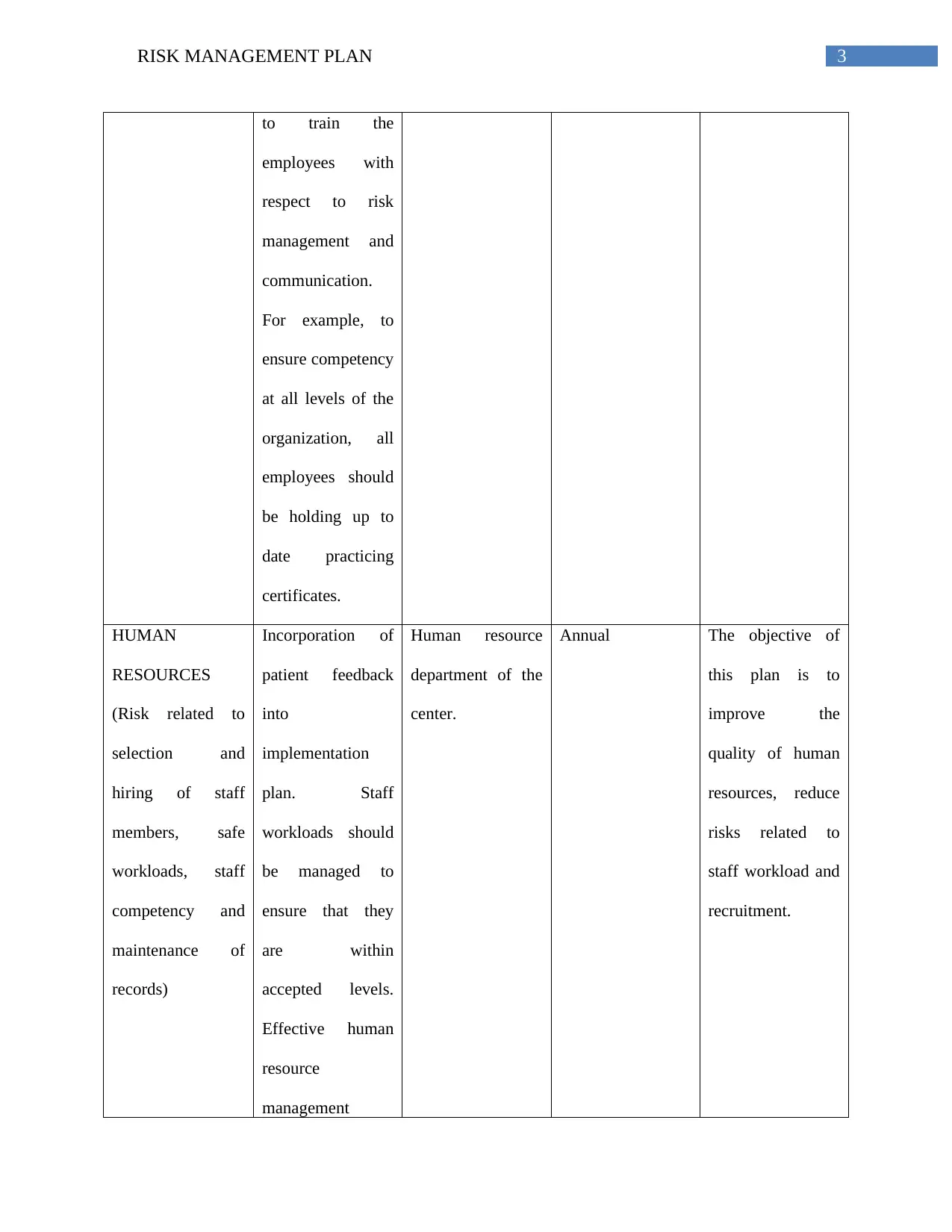
3RISK MANAGEMENT PLAN
to train the
employees with
respect to risk
management and
communication.
For example, to
ensure competency
at all levels of the
organization, all
employees should
be holding up to
date practicing
certificates.
HUMAN
RESOURCES
(Risk related to
selection and
hiring of staff
members, safe
workloads, staff
competency and
maintenance of
records)
Incorporation of
patient feedback
into
implementation
plan. Staff
workloads should
be managed to
ensure that they
are within
accepted levels.
Effective human
resource
management
Human resource
department of the
center.
Annual The objective of
this plan is to
improve the
quality of human
resources, reduce
risks related to
staff workload and
recruitment.
to train the
employees with
respect to risk
management and
communication.
For example, to
ensure competency
at all levels of the
organization, all
employees should
be holding up to
date practicing
certificates.
HUMAN
RESOURCES
(Risk related to
selection and
hiring of staff
members, safe
workloads, staff
competency and
maintenance of
records)
Incorporation of
patient feedback
into
implementation
plan. Staff
workloads should
be managed to
ensure that they
are within
accepted levels.
Effective human
resource
management
Human resource
department of the
center.
Annual The objective of
this plan is to
improve the
quality of human
resources, reduce
risks related to
staff workload and
recruitment.
Paraphrase This Document
Need a fresh take? Get an instant paraphrase of this document with our AI Paraphraser
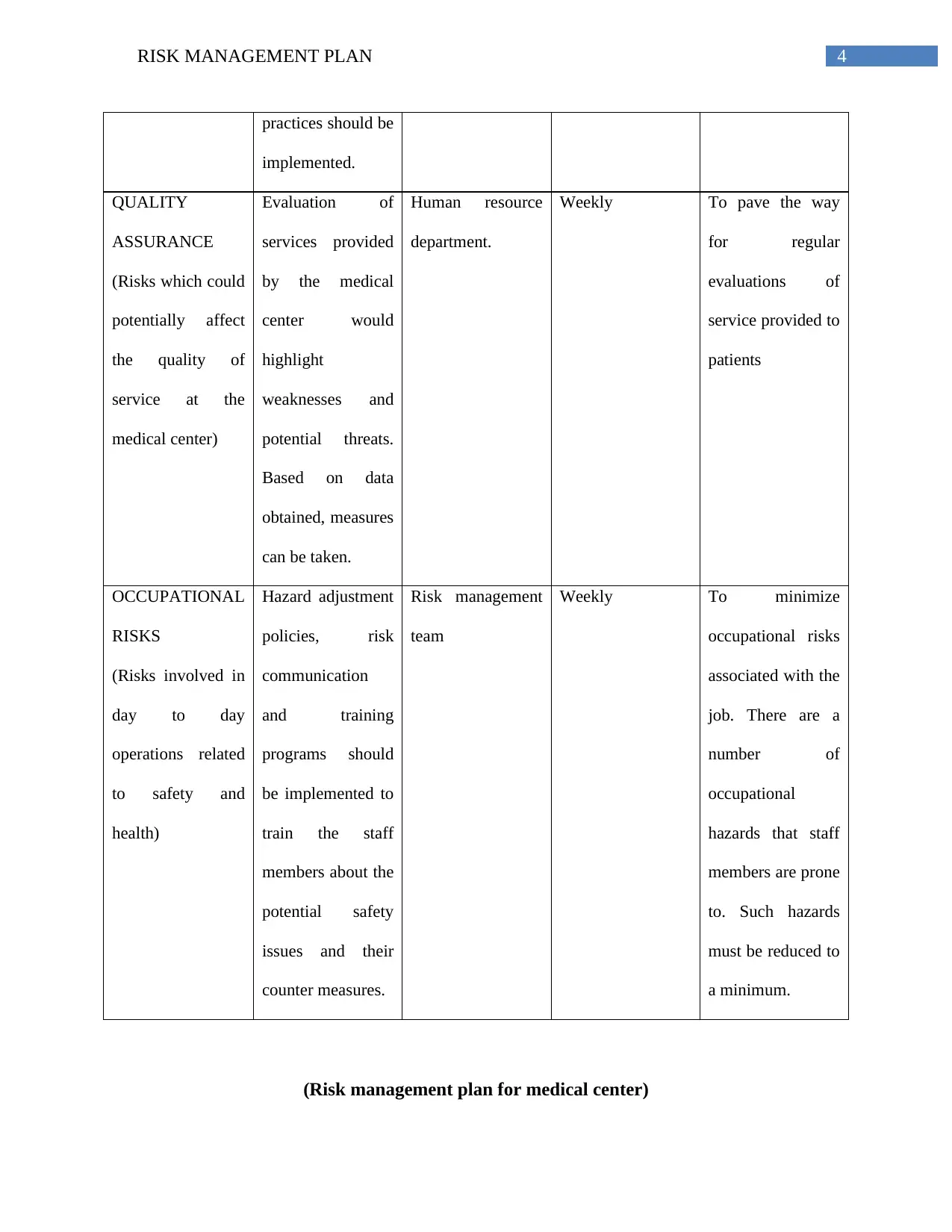
4RISK MANAGEMENT PLAN
practices should be
implemented.
QUALITY
ASSURANCE
(Risks which could
potentially affect
the quality of
service at the
medical center)
Evaluation of
services provided
by the medical
center would
highlight
weaknesses and
potential threats.
Based on data
obtained, measures
can be taken.
Human resource
department.
Weekly To pave the way
for regular
evaluations of
service provided to
patients
OCCUPATIONAL
RISKS
(Risks involved in
day to day
operations related
to safety and
health)
Hazard adjustment
policies, risk
communication
and training
programs should
be implemented to
train the staff
members about the
potential safety
issues and their
counter measures.
Risk management
team
Weekly To minimize
occupational risks
associated with the
job. There are a
number of
occupational
hazards that staff
members are prone
to. Such hazards
must be reduced to
a minimum.
(Risk management plan for medical center)
practices should be
implemented.
QUALITY
ASSURANCE
(Risks which could
potentially affect
the quality of
service at the
medical center)
Evaluation of
services provided
by the medical
center would
highlight
weaknesses and
potential threats.
Based on data
obtained, measures
can be taken.
Human resource
department.
Weekly To pave the way
for regular
evaluations of
service provided to
patients
OCCUPATIONAL
RISKS
(Risks involved in
day to day
operations related
to safety and
health)
Hazard adjustment
policies, risk
communication
and training
programs should
be implemented to
train the staff
members about the
potential safety
issues and their
counter measures.
Risk management
team
Weekly To minimize
occupational risks
associated with the
job. There are a
number of
occupational
hazards that staff
members are prone
to. Such hazards
must be reduced to
a minimum.
(Risk management plan for medical center)
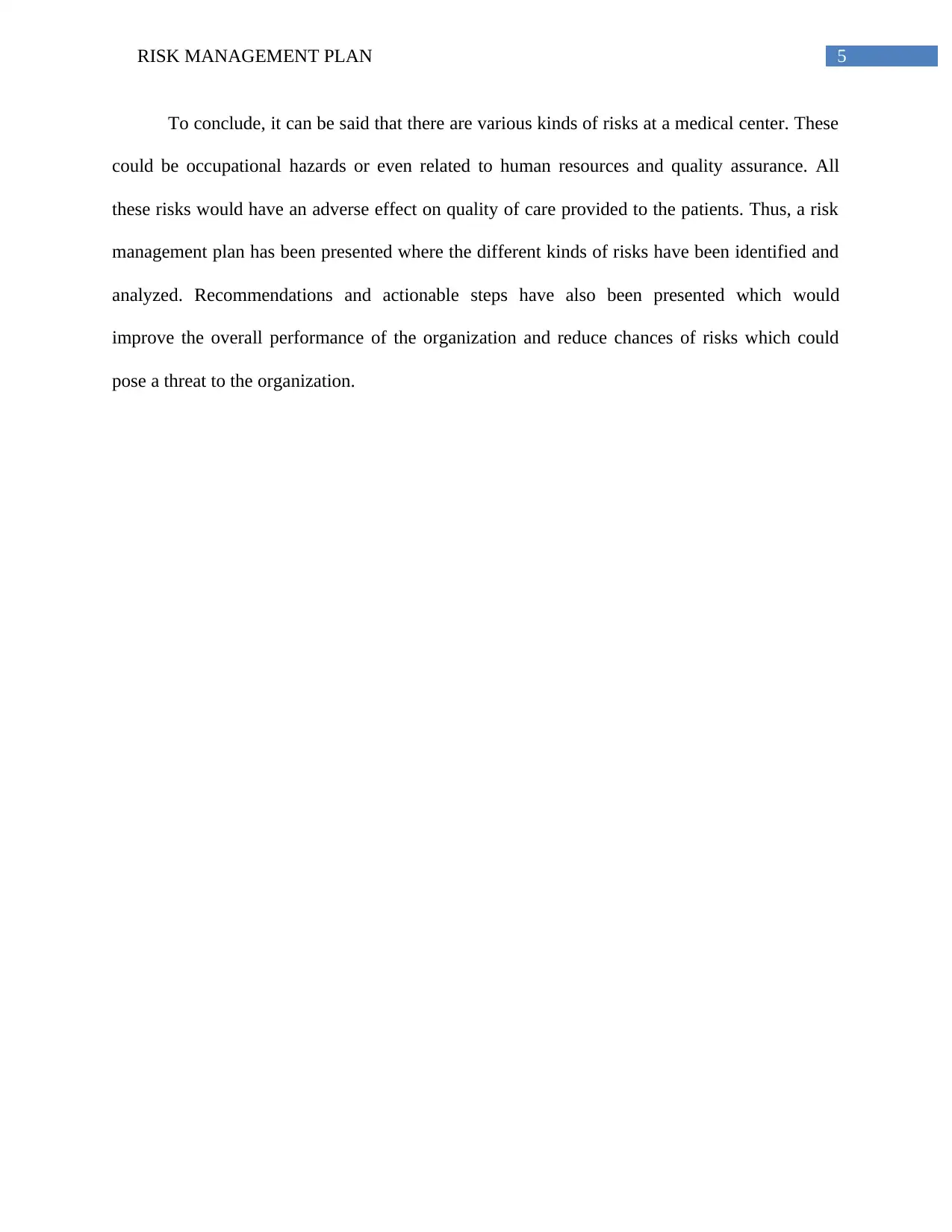
5RISK MANAGEMENT PLAN
To conclude, it can be said that there are various kinds of risks at a medical center. These
could be occupational hazards or even related to human resources and quality assurance. All
these risks would have an adverse effect on quality of care provided to the patients. Thus, a risk
management plan has been presented where the different kinds of risks have been identified and
analyzed. Recommendations and actionable steps have also been presented which would
improve the overall performance of the organization and reduce chances of risks which could
pose a threat to the organization.
To conclude, it can be said that there are various kinds of risks at a medical center. These
could be occupational hazards or even related to human resources and quality assurance. All
these risks would have an adverse effect on quality of care provided to the patients. Thus, a risk
management plan has been presented where the different kinds of risks have been identified and
analyzed. Recommendations and actionable steps have also been presented which would
improve the overall performance of the organization and reduce chances of risks which could
pose a threat to the organization.
⊘ This is a preview!⊘
Do you want full access?
Subscribe today to unlock all pages.

Trusted by 1+ million students worldwide
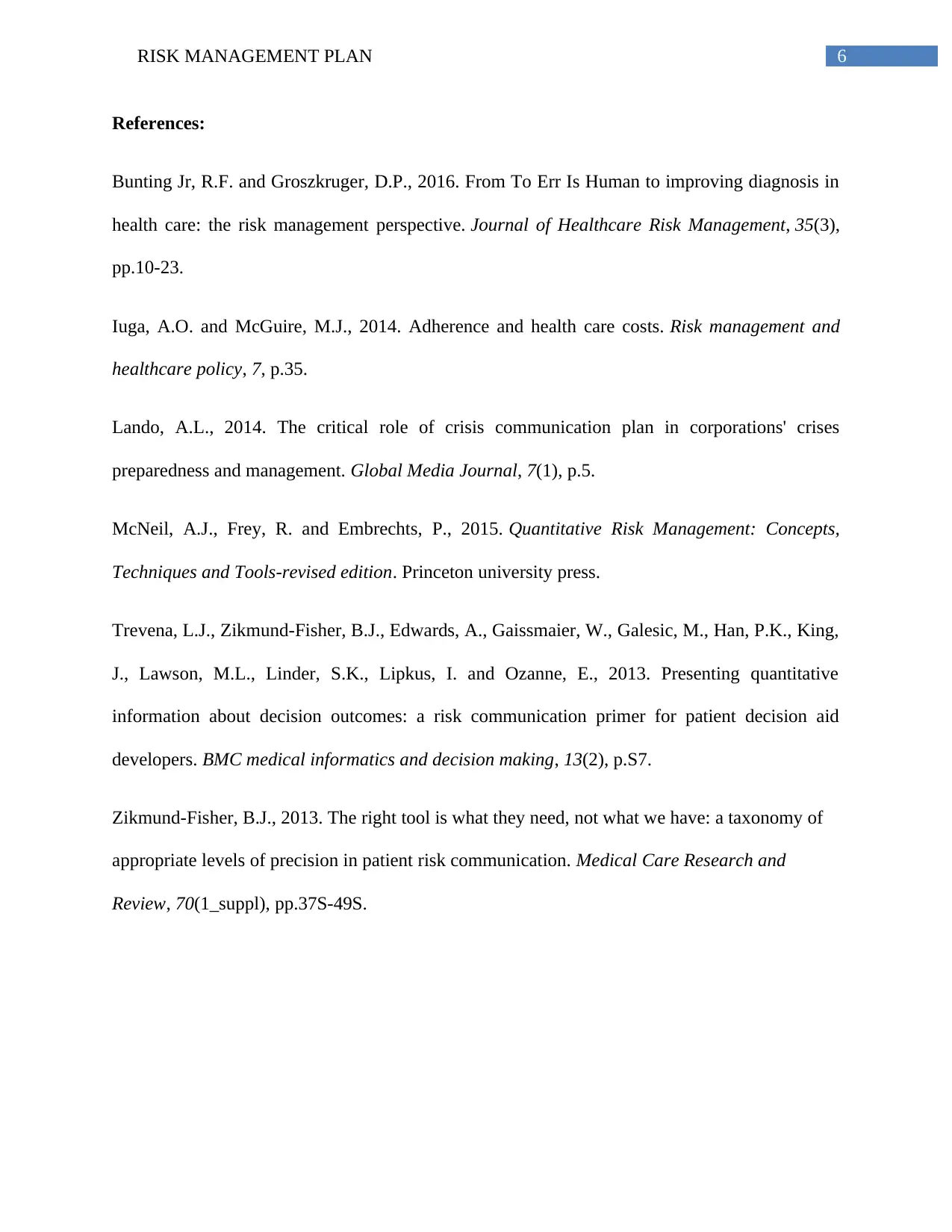
6RISK MANAGEMENT PLAN
References:
Bunting Jr, R.F. and Groszkruger, D.P., 2016. From To Err Is Human to improving diagnosis in
health care: the risk management perspective. Journal of Healthcare Risk Management, 35(3),
pp.10-23.
Iuga, A.O. and McGuire, M.J., 2014. Adherence and health care costs. Risk management and
healthcare policy, 7, p.35.
Lando, A.L., 2014. The critical role of crisis communication plan in corporations' crises
preparedness and management. Global Media Journal, 7(1), p.5.
McNeil, A.J., Frey, R. and Embrechts, P., 2015. Quantitative Risk Management: Concepts,
Techniques and Tools-revised edition. Princeton university press.
Trevena, L.J., Zikmund-Fisher, B.J., Edwards, A., Gaissmaier, W., Galesic, M., Han, P.K., King,
J., Lawson, M.L., Linder, S.K., Lipkus, I. and Ozanne, E., 2013. Presenting quantitative
information about decision outcomes: a risk communication primer for patient decision aid
developers. BMC medical informatics and decision making, 13(2), p.S7.
Zikmund-Fisher, B.J., 2013. The right tool is what they need, not what we have: a taxonomy of
appropriate levels of precision in patient risk communication. Medical Care Research and
Review, 70(1_suppl), pp.37S-49S.
References:
Bunting Jr, R.F. and Groszkruger, D.P., 2016. From To Err Is Human to improving diagnosis in
health care: the risk management perspective. Journal of Healthcare Risk Management, 35(3),
pp.10-23.
Iuga, A.O. and McGuire, M.J., 2014. Adherence and health care costs. Risk management and
healthcare policy, 7, p.35.
Lando, A.L., 2014. The critical role of crisis communication plan in corporations' crises
preparedness and management. Global Media Journal, 7(1), p.5.
McNeil, A.J., Frey, R. and Embrechts, P., 2015. Quantitative Risk Management: Concepts,
Techniques and Tools-revised edition. Princeton university press.
Trevena, L.J., Zikmund-Fisher, B.J., Edwards, A., Gaissmaier, W., Galesic, M., Han, P.K., King,
J., Lawson, M.L., Linder, S.K., Lipkus, I. and Ozanne, E., 2013. Presenting quantitative
information about decision outcomes: a risk communication primer for patient decision aid
developers. BMC medical informatics and decision making, 13(2), p.S7.
Zikmund-Fisher, B.J., 2013. The right tool is what they need, not what we have: a taxonomy of
appropriate levels of precision in patient risk communication. Medical Care Research and
Review, 70(1_suppl), pp.37S-49S.
1 out of 7
Related Documents
Your All-in-One AI-Powered Toolkit for Academic Success.
+13062052269
info@desklib.com
Available 24*7 on WhatsApp / Email
![[object Object]](/_next/static/media/star-bottom.7253800d.svg)
Unlock your academic potential
Copyright © 2020–2025 A2Z Services. All Rights Reserved. Developed and managed by ZUCOL.




